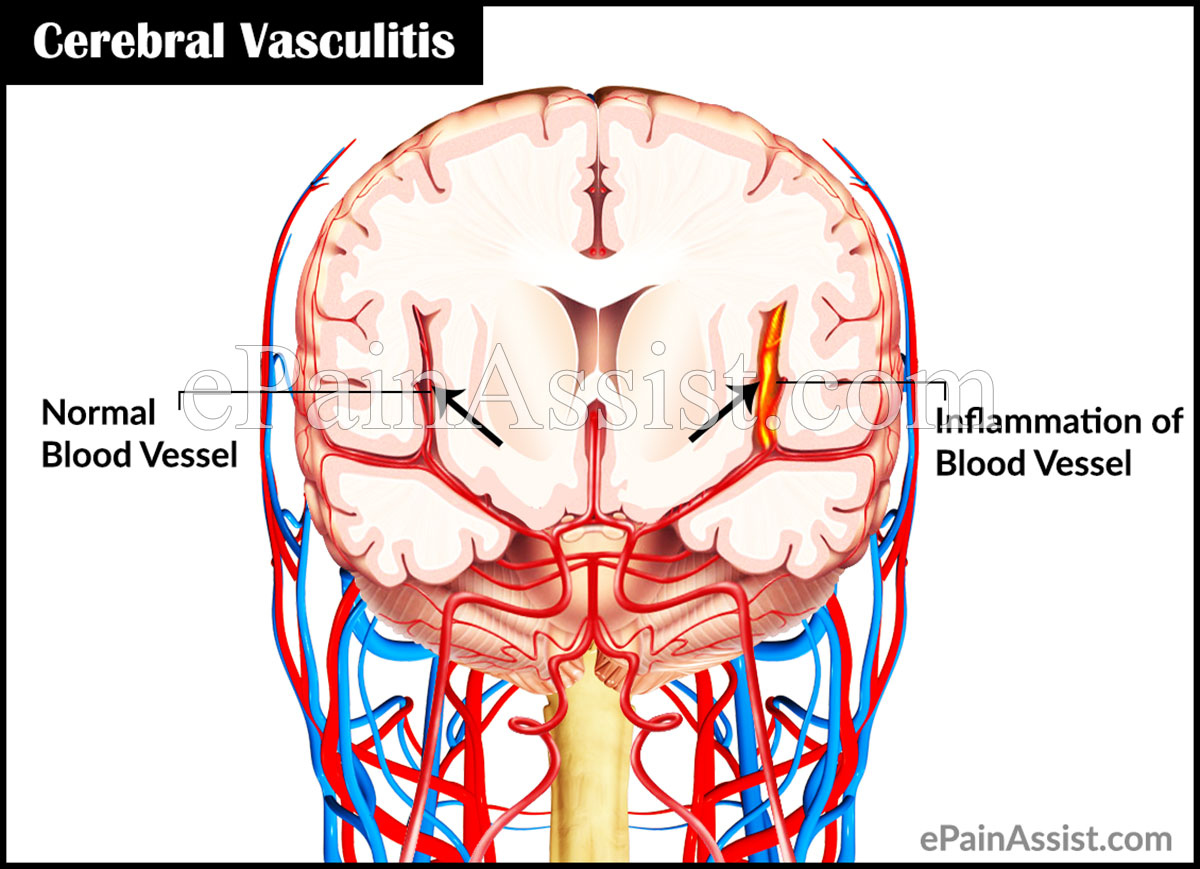Nervous system vasculitis is the inflammation of blood vessel. It is a rare disease. It is often accompanied by other autoimmune diseases like dermatomyositis, systemic lupus erythematosus and also in cases of rheumatoid arthritis. Wegener’s granulomatosis, Behcet’s syndrome, microscopic polyangiitis are some of the systemic diseases that can lead to cerebral vasculitis. However, there are cases, when the inflammation of the brain blood vessels occur in the absence of another cause, it is usually called Primary Angiitis of the Central Nervous System (PACNS).

Definition of Cerebral Vasculitis:
Cerebral Vasculitis represents a heterogeneous group of inflammatory diseases. It affects the walls of blood vessels in spinal cord, brain and the meninges.
Cerebral Vasculitis disrupts the normal physiologic and structural characteristics of the blood vessels in spinal cord, brain and the meninges. As a result this leads to the formation of aneurysms with consequent hemorrhage and ischemia.
Symptoms of Cerebral Vasculitis:
The symptoms of cerebral vasculitis include:
- Fatigue (tiredness)
- Nerve problems (including weakness, numbness and pain)
- Joint pains
- Skin rashes
- Fever
- General weakness
- Kidney problems (including dark or bloody urine)
- Abdominal (stomach) pain
- Ischemic attacks or mini strokes
- Problems with eyesight
- Confusion and forgetfulness.
Prognosis of Cerebral Vasculitis:
A relapse of the disease is seen occurring in about 25% of the cases of Cerebral Vasculitis. A total recuperation is possible if Cerebral Vasculitis is diagnosed at the earliest and is followed with correct and effective treatment. Delayed diagnosis of Cerebral Vasculitis can result in permanent neurological issues in the patient. Cerebral Vasculitis can take a more progressive form if it relapses after a long term and proves to be more complicated.
Epidemiology of Cerebral Vasculitis:
Variations in the mode of diagnosis and treatment make it difficult to make a conclusive assessment of the mortality rates associated with Cerebral Vasculitis. A recent account shows that about 14% of 29 patients suffering from Cerebral Vasculitis have expired. The male population is more vulnerable to the disease than the female with the occurrence ration being 7:3. Though it may affect people of all ages, people in the age group of 40 to 60 years have been found to be more susceptible.
Causes of Cerebral Vasculitis:
A clear and definite causative factor behind the occurrence of Cerebral Vasculitis has not yet been discovered. In some of the cases, aberrant antibodies, also known as autoantibodies are seen attacking the white blood cells, leading an attack on the walls of the vessels, thereby causing inflammation. In other cases, infection as a result of a virus can also cause Cerebral Vasculitis.
Diagnosis of Cerebral Vasculitis:
The slow onset of the symptoms of Cerebral Vasculitis leads to delayed diagnosis of the disease. It can take months and sometimes years to diagnose the disease. Usually the medical history and symptoms help the doctor to diagnose the condition clinically. The symptoms that are commonly associated with this disease and are diagnosed as a possibility of cerebral vasculitis are:
- A high white blood cell count
- Anemia (a shortage of red blood cells)
- A high platelet count
- Allergic reactions
- Kidney or liver problems
- Antibodies (tools the body uses to fight off threats)
- Immune complexes
- Elevation of inflammatory markers.
Physicians conduct a number of tests in order to assess if the patient is suffering from Cerebral Vasculitis. Generally patients are made to undergo tests such as, cerebral angiography, MRI, CT Scans, brain biopsy, Digital Subtraction Angiography and the like. Though blood test results often come out to be normal, they might manifest signs of inflammation. However, it has to be kept in mind that the result of all these tests can be negative which is misleading. Apart from all the afore-mentioned tests, a thorough examination of the medical history of the family as well as the patient is also made. It is also important to exclude the possibilities of cancer and other complications arising out of infections as they often manifest similar symptoms.
Treatment of Cerebral Vasculitis:
Cerebral Vasculitis is an extremely rare condition that proves not only difficult to diagnose but also includes a lot of variations in the method of diagnosis and treatment. Patients are generally prescribed high doses of steroids such as prednisone and glucocorticoids in combination with cyclophosphamide. Lower doses of immunosuppressant are then prescribed in order to establish long-term remission. Treatment of other diseases associated with Vasculitis is also done in order to reduce complications.
The difficulty in diagnosis makes it very important to not delay as soon as a symptom is noticed. However, there is no reason to fear. A thorough evaluation of the medical history, family history and assessment of the diagnostic test reports helps in proper diagnosis of the condition by the physician. A long term treatment can cure Cerebral Vasculitis and also prevent it from recurring in the future.
